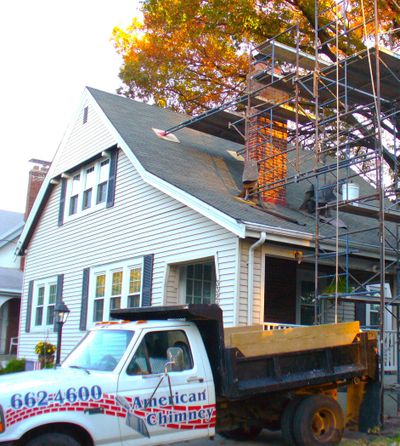Ask the Builder: How difficult can it be to repair a chimney?

DEAR TIM: The top 3 feet of my chimney needs to be rebuilt, and I’m homebound because of the pandemic. I’ve gone outside and stared up at the brick monolith projecting from the roof and pondered this project. How difficult can it be to do this repair? Do you have any tips, and can you help me convince my wife I’m able to complete this challenge successfully? – Tony G., Sharon, Connecticutt
A. The coronavirus pandemic has many climbing the walls of their homes looking for something to do. Many are tired of being treated like prisoners and are getting restless and reckless. Some are thinking about attempting an ambitious project that pushes on the edge of the envelope of their skills.
Here’s my advice: Step back and think before you act. The first thing that comes to mind in situations like this – and I was guilty of this when I was a very young and impressionable contractor – is you don’t know what you don’t know. Sometimes this is good because the lack of this filter fills you with confidence. You tend to ignore the chances of failure or disaster.
But it can get you into trouble faster than ants show up at a picnic. You can cause serious damage to yourself and your home if you don’t have a clue about all the secondary effects of an uninformed decision. For example, you might decide to tear down a bearing wall to make two rooms one room. You might not think about how much weight might be bearing on just two or three wall studs. It can be several tons.
Let’s look at the chimney project. For starters, how in the world do you intend to work on the chimney? If you’ve got a simple ranch home with a low-slope roof like my father-in-law’s house, where the chimney is easy to stand next to, no problem. But what about steeper roofs? Chimney repair requires specialized scaffolding.
Chimney restoration companies use scaffolding to create work platforms on all four sides of a chimney. It requires experience to put up this scaffolding safely. You can’t hope it’s going to work. The dynamics of the scaffolding change when you load the work platforms with hundreds of pounds of brick and buckets of mortar.
You have to tear apart the top 3 or 4 feet of your chimney as it’s deteriorated. You need to know how to salvage the brick and inspect it for damage. The same is true for the flue liners.
When it’s time to start rebuilding, you will want to read all the past columns on my askthebuilder.com website about chimney crown construction, chimney crown flashings and the all-important hydrated lime mortar. Hydrated lime is one of the best secrets about masonry construction, but unfortunately it has fallen from favor over the past few decades. I’m determined not to let it disappear.
Your chimney probably suffered damage because the crown was never built right in the first place. I’d venture that not 1 in 1,000 chimney crowns is installed correctly. I discovered about 25 years ago the proper way to build one.
It’s very important to understand the chimney crown is the roof of your chimney. If the roof on your home leaks water into the inside, you know that very soon you’ll have damage to your ceilings, walls and possessions. The same is true for chimneys. You can’t allow rainwater to leak down through the crown into the center of the chimney.
The Brick Industry Association has published for many years very detailed instructions on how chimney crowns should be built and detailed. You can get this information for free from their website or at askthebuilder.com. I beg you to do this if you hire a contractor to rebuild your chimney. The issue I’ve discovered is many brick masons have never been exposed to the BIA and its vast library of technical notes.
It’s your chimney and your money. Print out the details offered up by the BIA and hand these to each contractor bidding the job. If they scoff at and ridicule them, thank the contractor for their time and usher them off your property. Make it clear your chimney must be rebuilt in the manner the BIA stipulates. As for convincing your wife you can do the job, I’ll pass on that conversation.
The only way I’d maybe give you a vote of confidence is if you buy scrap cheap brick and you build a test chimney about 30 inches high on a piece of plastic in your garage. Once you see how difficult it is to keep the brick level and plumb and not have mortar smeared all over the brick, then and only then might I say to your wife, “Be sure the life and health insurance premiums are paid up!”
Subscribe to Tim Carter’s free newsletter at askthebuilder.com.